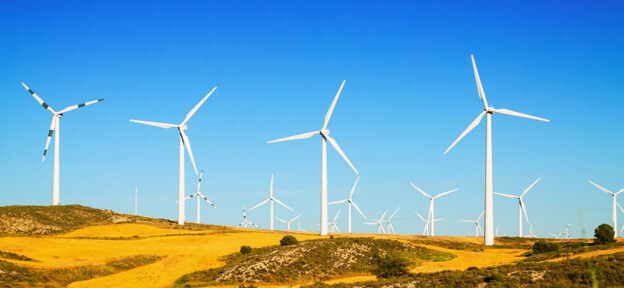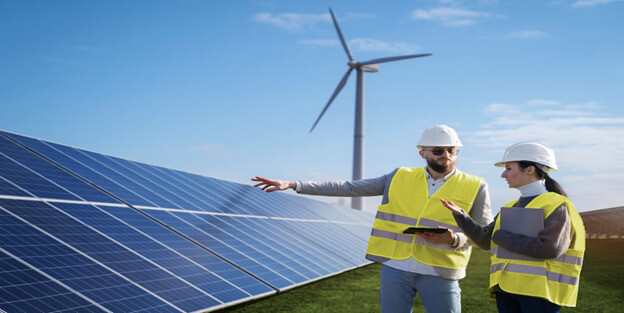Overview of Wind Turbine
Wind turbines are one type of renewable energy technology that converts wind’s kinetic energy into mechanical energy. Wind turbine installations are typical in windy areas such as hills and coastlines, where there is a steady flow of current. They can generate electricity for residential, commercial, and industrial applications. Wind turbines are a clean and efficient way of generating electricity without producing emissions. They also require very little maintenance and have a long lifespan.
(Image Credit: Freepik)
Working
An electrical generator converts wind turbines’ mechanical energy into electrical energy. The rotor, made up of several blades, catches the wind and causes the shaft to spin. This spinning shaft is connected to an electrical generator. The generator then converts the spinning motion into electrical energy utilized in homes and businesses.
(Image Credit: Freepik)
Advantages and Disadvantages of Wind Turbine
Let’s look at some of the advantages and disadvantages of wind turbines:-
Advantages
Wind turbines are the most efficient and cost-effective sources of renewable energy available today. They are used to generate electricity from the kinetic energy of the wind. Wind turbines are becoming increasingly popular due to their numerous advantages, which include the following:
- Clean Power Source: Wind turbines are a clean energy source as they do not emit pollutants or greenhouse gasses into the atmosphere.
- Low Maintenance Costs: Wind turbines require very little maintenance, as there are no moving parts and minimal lubrication. It means that the cost of care is much lower than for other forms of energy generation.
- Low Operating Costs: Wind turbines require very little energy, as the wind powers them. It means that energy generation costs are much lower than other forms of energy.
- High Efficiency: Wind turbines are highly efficient, as they can capture energy from the wind and convert it into electricity. It means that the power generated is much higher than other forms of energy generation.
- Flexibility: Wind turbines can be installed in various locations and can generate power in remote locations. It makes them ideal for areas where other forms of energy generation are not viable.
- Space-saving: Wind turbines are relatively small and take up very little space. The compact design of these units allows for installation in areas with limited space availability.
- Versatility: Wind turbines can be utilized in various applications, such as powering homes and businesses, providing backup power, and providing energy for transportation.
- Low Impact on the Environment: Wind turbines have a minimal impact on the environment, as they do not produce any pollutants or greenhouse gases.
Disadvantages
- Noise Pollution: Wind turbines are a source of noise pollution. The blades of wind turbines create a “whooshing” sound as they turn and can be heard from a long distance away. It is especially true for large-scale wind farms and can be disruptive to people living nearby.
- Bird and Bat Deaths: Wind turbines can hazard birds and bats. The spinning blades can cause injury or death when the animals fly too close to them. Wind turbines are usually placed in areas with a lot of bird and bat activity, making this an unavoidable problem.
- Land Use: Wind turbines require a lot of space to be installed and maintained. Installing turbines requires significant acreage, which may impede land utilization for alternative endeavors.
- Cost: Wind turbines are expensive to install and maintain. Setting up a wind farm is usually more costly than other forms of energy production, like natural gas or oil.
- Maintenance: Wind turbines require frequent maintenance to keep them running efficiently. We must retain highly skilled and trained technicians to ensure the effective functioning of our operations to conduct regular inspections and maintenance on the turbines to ensure optimal performance and prolong the lifespan of the equipment.
- Weather Dependency: Wind turbines only work when there is wind, making them dependent on the weather. It means they need to produce a consistent and reliable energy source.
- Location: Wind turbines must be placed in areas with strong and consistent winds to work correctly. It means they can only be placed in some areas, limiting their potential use.
Conclusion
The wind turbine is an important renewable energy technology that can generate electricity in residential and commercial settings. Wind turbines offer several advantages, including low operating costs and emissions, a long lifespan, and the potential to produce more energy than they consume. However, they also have some limitations, such as the need for windy conditions to generate power, difficulty predicting wind patterns, and noise pollution. With proper planning, wind turbines can be an effective way to reduce energy costs and reduce reliance on fossil fuels.
Recommended Articles
We hope that this EDUCBA information on “Advantages and Disadvantages of Wind Turbine” was beneficial to you. You can view EDUCBA’s recommended articles for more information,


